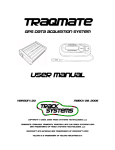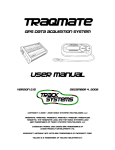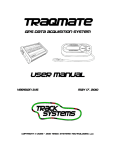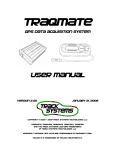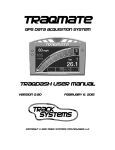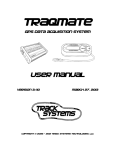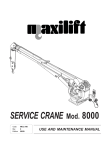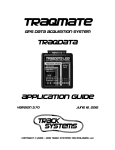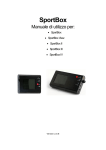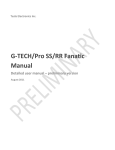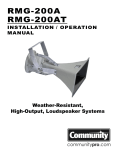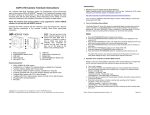Download Traqmate User Manual..
Transcript
Traqmate GPS Data Acquisition System User Manual Version 1.05 December 30, 2005 Copyright © 2005, 2006 Track Systems Technologies, LLC Traqmate, Traqview, and the track systems logo are trademarks of track systems technologies, llc Microsoft and windows are trademarks of Microsoft corp. Velcro is a trademark of Velcro Industries B.V. Traqmate User Manual V1.05 December 30, 2005 This page intentionally left blank. Copyright © 2005,2006 Track Systems Technologies, LLC Page 2 Traqmate User Manual V1.05 December 30, 2005 Table of Contents WELCOME TO TEAM TRAQMATE ............................................................................................... 4 SYSTEM OVERVIEW ..................................................................................................................... 5 TRAQMATE FEATURES .................................................................................................................... 5 TRAQMATE SYSTEM COMPONENTS ................................................................................................. 6 TRAQMATE SYSTEM PACKAGES ...................................................................................................... 8 TRAQVIEW SOFTWARE INSTALLATION .................................................................................... 9 TRAQVIEW ANALYSIS SOFTWARE .................................................................................................... 9 USB DRIVER ................................................................................................................................. 9 TRAQMATE INSTALLATION....................................................................................................... 10 SENSOR UNIT INSTALLATION ......................................................................................................... 10 SENSOR AND DISPLAY UNIT OPERATION........................................................................................ 11 SENSOR UNIT ONLY OPERATION ................................................................................................... 11 GPS ANTENNA PLACEMENT ......................................................................................................... 11 CONNECTING A SENSOR UNIT TO A DISPLAY UNIT .......................................................................... 11 POWER CONNECTION ................................................................................................................... 12 TRAQMATE DISPLAY UNIT INSTALLATION ....................................................................................... 13 TRAQMATE BASIC ...................................................................................................................... 15 SYSTEM DESCRIPTION .................................................................................................................. 15 CONTROLS ................................................................................................................................... 15 TRAQMATE COMPLETE ............................................................................................................. 16 SYSTEM DESCRIPTION .................................................................................................................. 16 CONTROLS ................................................................................................................................... 16 MENU SYSTEM ............................................................................................................................. 17 FEATURES ................................................................................................................................... 18 TRAQVIEW ANALYSIS AND CONFIGURATION PROGRAM.................................................... 20 TOOLBAR BUTTONS AND CONTROLS ............................................................................................. 20 MENU OPTIONS ............................................................................................................................ 20 FILES ........................................................................................................................................... 21 VIEWING OPTIONS ........................................................................................................................ 21 EXCHANGING INFORMATION WITH TRAQMATE ................................................................................ 22 UNIT INFO SCREEN ....................................................................................................................... 23 ANALYSIS TOOLS.......................................................................................................................... 25 USING TRAQMATE FOR ANALYSIS .......................................................................................... 33 DRIVER COMPARISON ................................................................................................................... 33 VEHICLE PERFORMANCE COMPARISON ......................................................................................... 37 SAFETY........................................................................................................................................ 38 SHARE & COMPARE – TRAQMATE.COM ................................................................................. 40 EXCHANGING LAPS ....................................................................................................................... 40 APPENDICES ............................................................................................................................... 41 TABLE OF FIGURES ....................................................................................................................... 41 SYSTEM REQUIREMENTS .............................................................................................................. 42 WARRANTY INFORMATION ............................................................................................................. 42 GLOSSARY ................................................................................................................................... 43 ABOUT GPS DATA ACQUISITION ................................................................................................... 44 Copyright © 2005,2006 Track Systems Technologies, LLC Page 3 Traqmate User Manual V1.05 December 30, 2005 Welcome to Team Traqmate Thank you for purchasing the Traqmate System, the powerful but easy-to-use Data Acquisition System. You will be amazed at the depth of information available without modifying your vehicle or learning to decipher complicated data tables. Traqmate was designed by racers and is great for getting the first or last second out of your lap times. It is also great for the track day enthusiast who wants to record their day, play it back with their video, analyze their performance to get the most out of their car, and do a little bench racing with their friends. With the addition of this small device to your track bag, you will be able to better tune car and driver for maximum performance. While it is very easy to learn, please take a moment to read this manual so you can discover all the capabilities and get the most out your Traqmate. As a Traqmate owner, you really are a member of Team Traqmate. Use the traqmate.com website Share and Compare, trading laps with thousands of other Traqmate enthusiasts around the world. We at Track Systems are continually improving Traqmate and Traqview by adding additional innovative features that are available to download so make sure you check traqmate.com frequently for the latest software. See you at the track, Glenn Stephens President Track Systems Technologies, LLC Copyright © 2005,2006 Track Systems Technologies, LLC Page 4 Traqmate User Manual V1.05 December 30, 2005 System Overview The Traqmate is a vehicle data acquisition device that uses a high-speed GPS receiver and highresolution accelerometers to track and record the speed of a vehicle, its absolute location, and forces acting on the vehicle. The Track Systems Traqview analysis program uses advanced mathematic algorithms to translate this data into visual form where it is easy to spot differences between drivers, vehicles, and sessions. Traqmate Features Drop and Go – Stick a Traqmate in your car, turn it on, and collect data all day long. No sensors required. Replay Your Day – Upload the data into Traqview. See your car on the track and your performance on the virtual dashboard. Instant Gratification – See your lap times as they happen on the in-car display. Share and Compare – Create virtual races with friends or with yourself from different sessions. Trade laps with your friends. Learn from them. Easy to Use – No engineering degree required. The Traqmate Sensor Unit has one button. What could be easier? The Traqmate Display Unit is menu-driven with prompts in English. Just pick what you want – no typing, no memorizing buttons. Analyze – Zoom in on your lap. Single step to see G loads and speed. Compare braking and acceleration points between cars and drivers. Graph data vs. time and distance. Share Your Toys – Loan your Traqmate to a friend or loan your car to a faster driver. Then compare their laps against your own. Even two drivers with equal laptimes can both learn from each other. Rugged – Traqmate was designed to withstand the tough environment of a race car to give you years of service. Grow – Want even more information? Add sensors for digital, analog, and frequency inputs.1 It Gets Better – Traqmate’s heart is a very powerful microprocessor so new features and functionality will be made available over time. Download new software from traqmate.com, reprogram the unit, and you are good to go. 1 Future software release. Copyright © 2005,2006 Track Systems Technologies, LLC Page 5 Traqmate User Manual V1.05 December 30, 2005 Traqmate System Components The Traqmate System has three main components – the Sensor Unit (SU) contains the sensitive electronics to measure location and G-forces. The Display Unit (DU) contains a graphical display for viewing laptimes as they happen. The final component is Traqview, the innovative Windows software that allows you to view your performance in many different ways. Sensor Unit In addition to the GPS receiver to measure position and the accelerometers to measure forces, the Sensor Unit has digital, analog, and frequency inputs for measuring individual aspects of vehicle performance such as RPM or steering wheel position. These are recorded alongside the position and force data for easy graphing.2 Four LEDs indicate power, data collection mode, GPS signal, and data communications activity. The single button is used for ON/OFF and for entering and exiting data communications mode. The Sensor Unit can be used standalone or in conjunction with a Display Unit, in which case it is entirely remotely controlled. The Sensor Unit can be customized using the Traqview Analysis Program. You can enter Drivers, Tracks, and Vehicles and all data is date and time-stamped so there is never any confusion. In addition, Traqview lets you customize the unit with your name and contact information in case it is lost or stolen. Display Unit The Display Unit (DU) is a major leap in low-cost data acquisition providing in-car lap timing without a need for external beacons. The graphical and menu-driven user interface makes data collection easy and fun. Even more innovative, the DU is a USB-powered data storage device. Unclip it from your car and plug it into your PC’s USB port. The Display Unit powers up and transfers your data right into Traqview where your sessions are listed by Driver, Track, and Vehicle. The DU has a backlit bitmapped screen for easy reading day or night. The membrane switch has large buttons so it can be accessed with gloves and is resistant to moisture, dirt, and grease. Mount it anywhere with Velcro or the accessory quick clip. With the Traqmate DU, in-car lap timing has never been easier. For each track, press the SELECT button at the start/finish line to permanently store that information in the DU. The unit will remember that track in the future. Place the unit in Lapping Mode and watch your laps click off. The display shows Lap Number, Lap Time, Best Lap, and whether the lap was faster or slower that the previous lap. Lap Timing continues even if GPS signal is lost or spotty. Review laps for any session and delete the ones you don’t want. The Display Unit is attractive enough to use every day. When traveling to the track, turn on the DU and you will get a nice GPS compass, atomic clock, and a speedometer. 2 Available in next software release. Copyright © 2005,2006 Track Systems Technologies, LLC Page 6 Traqmate User Manual V1.05 December 30, 2005 Traqview A data acquisition system is only as good as the analysis program. Traqview is a new approach that merges hardcore data analysis with the fun of a video game. The track mapping is accurate and gives an instant read on what is happening where. Multi-car playback lets you see graphically who is faster where. Record several cars in a race and replay the entire race in real-time, slow-mo, or fast forward. See their speed, G loads, braking and acceleration for every car on the virtual dashboard. Traqview has all the tools you need to optimize the performance of both car and driver. For example, you can display graphs like Velocity vs. Distance to see who is faster in which corners and then define a sector on the map and zoom in to see braking points, instantaneous velocities, acceleration points, and transfer speeds through a corner. Traqview is your single point of contact for everything in the Traqmate System. Use it to upload data from Traqmate, analyze the data, configure Tracks, Drivers, Vehicles and optional Sensors, change the Sampling Rate, and even download future software and feature upgrades into your Traqmate. Copyright © 2005,2006 Track Systems Technologies, LLC Page 7 Traqmate User Manual V1.05 December 30, 2005 Traqmate System Packages This diagram will help you identify the Traqmate Components. Traqmate comes as two bundled packages. Each includes everything you need to collect and analyze your data. Traqmate Basic The Traqmate Basic package consists of a Sensor Unit (SU), GPS antenna, serial cable, cigarette lighter power adapter, carrying box, and compact data disc containing the Traqview Analysis software and manual. Traqmate Complete The Traqmate Complete package consists of a Sensor Unit (SU), a Display Unit (DU), GPS antenna, USB cable, SU-DU DIN connection cable, cigarette lighter power adapter, carrying box, and compact data disc containing the Traqview Analysis Software and User Manual. Figure 1 - Traqmate System Components Accessories Accessories include a TraqPaq battery pack, permanent vehicle power harness, DU mounting bracket, TraqAC SU AC adapter, extra antennas for convenient vehicle swapping, and SU mounting tray. TraqPaq Battery Pack SU Mounting Tray DU Mounting Bracket TraqAC Power Supply Copyright © 2005,2006 Track Systems Technologies, LLC Permanent Power Cable Page 8 Traqmate User Manual V1.05 December 30, 2005 Traqview Software Installation NOTE: It is important to install the software and USB driver before plugging the unit into your PC. Traqview is designed to work with most current Microsoft Windows compatible computers. Check the Systems Requirements section of this manual to ensure that your system is compatible. To install the software, insert the compact disc into your PC’s compact disc drive. If you do not have a CD reader on your PC, you can download the software and user manual from the Traqmate website at traqmate.com. You may also check there for software updates. The CD should automatically run when inserted. If it does not, open “My Computer” and right-click on the CD drive. Choose “Explore”. Now double-click TraqSetup.exe to run the installer program. Traqview Analysis Software The Traqview Installer program is self-explanatory. The default options work well for most systems. The program is placed in the “Program Files/Track Systems folder”. If you have a Display Unit you should install “USB Pre-Installer”. You may de-select this option if you are installing a Traqview Basic system. When finished, you should get an indication that the new hardware was installed automatically. You should not have to repeat this installation in the future. USB Driver Once the USB drivers are installed, get your Display Unit and the mini-USB cable. Plug the cable into the DU and into a USB port on your computer. The Display Unit should power up and your computer will announce “Found New Hardware”. The New Hardware Wizard will execute for the Traqmate USB Composite Device. Choose to search ‘This Time Only’ and ‘Install Automatically’. When given a warning, choose to ‘Continue Anyway’. The New Hardware Wizard will execute for the Track Systems Traqmate. Choose to search ‘This Time Only’ and ‘Install Automatically’. When given a warning, choose to ‘Continue Anyway’. Depending on what drivers and libraries were installed, you may be asked to restart your computer. You will not have to install this driver again in the future. Note: If at any time during the install the installer cannot location the USB drivers, you may manually enter: C:\Program Files\Track Systems\Traqmate\USB Copyright © 2005,2006 Track Systems Technologies, LLC Page 9 Traqmate User Manual V1.05 December 30, 2005 Traqmate Installation These diagrams show the overall connections for the Traqmate Basic and Traqmate Complete Systems. Figure 2 - Traqmate Basic Connections Figure 3 - Traqmate Complete Connections Sensor Unit Installation The Traqmate sensor unit may be mounted using a variety of methods depending on the following factors: 1) How permanent is the desired mount, 2) where is the preferred mounting point, 3) will the SU be connected to a Display Unit (DU). The Sensor Unit must be mounted as flat as possible in the vehicle and such that the arrow on the top label points in the direction of travel. CHOOSE A LOCATION WHERE THE UNIT WILL NOT BE SUBJECTED TO WATER. EXCESSIVE MOISTURE EXPOSURE WILL DAMAGE THE UNIT. This is to ensure the accelerometers are the most accurate and have the best range for making measurements. It is also a good idea to place the unit as close to the vehicle’s center of gravity as possible. While not required, especially with connection to the DU, it may be desirable to mount the SU in a location that allows the indicator lights to be viewed easily by the driver. Given these considerations, a position on the floor of the front passenger footwell may work well. The mounting of the SU may be accomplished in a variety of ways, but the most desirable and secure method is to use the Sensor Unit Copyright © 2005,2006 Track Systems Technologies, LLC Page 10 Traqmate User Manual V1.05 December 30, 2005 Mounting Tray (shown here), offered as a separate accessory from Track Systems. The mounting tray can be attached permanently to the vehicle, and by placing Velcro on the SU enclosure, and the mounting tray, the SU is securely fastened, while at the same time being easily removable. Once the mounting tray is aligned in the vehicle, the SU can be easily placed in the mounting tray and the alignment is set. Another method for mounting the SU is to apply Velcro directly to the SU and the mating piece directly to the vehicle. This care should be taken when placing the SU on the Velcro that it is properly aligned in the vehicle and that the SU is securely attached. Sensor and Display Unit Operation If the SU is going to be connected to a DU, the mounting of the SU is not as critical with respect to gathering and downloading data. In this configuration, the DU stores the data and is the focal point for downloading to a PC. Sensor Unit only Operation If the SU is going to be used in a configuration without the DU, it is desirable to have access to the SU for downloading the data once it has been stored. Similarly, if a laptop is going to be used to download the stored data without removing the SU, the unit should be placed in a convenient and accessible location. In the case where the SU will be removed to download the data, the mounting should take into account replacing the SU in a secure and aligned manner. GPS Antenna Placement The supplied GPS antenna has a magnetic mount, which allows a variety of mounting options to the metal chassis of the vehicle. In the case where the desired location is not metal, double stick tape is a viable option for mounting the antenna. The placement of the antenna can have a great effect on the performance of the data collection system. Ideally, the antenna should be placed on the highest part of the exterior of the vehicle. Placing the antenna inside the vehicle can cause “blind spots” where the antenna is not able to see as many of the GPS satellites that may be available to it. The system works best when the antenna has the least restricted view of the sky. Once a location has been determined for the antenna placement, the wire connecting the antenna and the SU should be routed in a manner such that it is not placed under stress, and the wire will not be exposed to frequent bending or crimping. After routing the wire to the SU, connect the antenna to the SU by screwing the antenna wire to the GPS connector indicated on the end panel of the SU. Connecting a Sensor Unit to a Display Unit In the configuration where the Sensor Unit and the Display Unit will both be used, a 15’ DIN-to-DIN connection cable is provided. This is a standard male-tomale cable, which allows a great deal of flexibility in the placement of the SU and DU. The length of the cable is typically sufficient such that it can be routed as to be securely protected from damage during normal vehicle operation. In the case where the distance between the SU and DU does not require a 15’ cable, a shorter version can be purchased at most computer or electronic supply stores. Copyright © 2005,2006 Track Systems Technologies, LLC Page 11 Traqmate User Manual V1.05 December 30, 2005 Power Connection In all installations, the SU must be supplied with a power source at all times it is in operation. For Traqmate Complete, the DU can receive power via the DIN extension cable from the SU or via the USB cable when connected to a PC for uploading sessions. The SU was designed to be powered from a +12 VDC battery supply in four different ways; a permanent wiring harness in the vehicle, a cigarette lighter adapter, a battery pack, and a wall charger. Each of these will be discussed separately. Cigarette Lighter Adapter For installations where a permanent power supply connection is not required or desired, the cigarette lighter adapter offers a quick and convenient solution. This adapter can be secured to the SU by inserting the plug into the power connector (PWR) on the SU and tightening the threaded nut to the power (PWR) socket. Once the SU and the power connector have been secured, the cigarette lighter adapter can be plugged into one of the cigarette lighter sockets located in the vehicle. It should be noted that many automobiles have cigarette lighter sockets that are always ON and do not turn the power off when the ignition switch has been turned to the OFF position. The cigarette lighter adapter has a RED LED to indicate that vehicle battery power is presented to the adapter. During extended vehicle idle periods, the cigarette lighter adapter should be removed from the vehicle socket to prevent vehicle battery drain. TraqPaq Battery Pack The TraqPaq can be utilized to power the SU during periods in which the SU is disconnected from the vehicle power and operation is still required, or in vehicles in which no installation has been performed. It is ideal for moving the SU from vehicle to vehicle. The TraqPaq Battery Pack is capable of supporting the SU power requirements for 3-5 hours using Alkaline batteries. DO NOT USE RECHARGEABLE NiCad BATTERIES since they do not provide enough voltage. This is generally enough time to run several track sessions, or all day if the unit is powered off between sessions. The SU can be powered by the TraqPaq during periods in which the SU data is being downloaded to a computer containing the Traqview software. The TraqPaq is attached to the SU by inserting the power plug into the power connector socket (PWR) on the SU. The TraqPaq power plug contains a threaded nut for securing the plug to the power jack (PWR) on the SU. The TraqPaq accommodates four (4) AA batteries that result in a 6 volt power source. Depleted batteries can be replaced by removing the screw and sliding the cover off. Care should be exercised when replacing the batteries, as to observe the polarity for each cell. Once the batteries have been properly installed, the cover should be replaced and secured by inserting and tightening the cover screw. Permanent Wiring Harness Installation The power cable is an 18 feet, two conductor, red and black zip cable that has a plug on one end and is not terminated on the other end. The power plug contains a threaded nut for securing the plug to the power jack (PWR) on the Traqmate Sensor Unit (SU). The other end of the cable is intended to connect to either the automobile battery or a junction box. Since the SU mounting location can vary widely (trunk, under seat, floorboard, etc.) the required cable length will also vary. Consequently, the cable can be cut to an appropriate length suitable for your automobile, once the mounting location is selected. Copyright © 2005,2006 Track Systems Technologies, LLC Page 12 Traqmate User Manual V1.05 December 30, 2005 Crimp Splice Vehicle +12V 3A 3AG Fuse 13' cable - cut to length Vehicle GND Power Connector Figure 4 - Permanent Wiring Harness The red wire is to be connected to the positive (+) side of the battery and the black lead to the negative (-) or chassis side. A fuse holder has also been included with the power cable. One end of the fuse holder contains a connector butt-splice and the other end is stripped for the application of a crimp lug or other suitable connector (not included). Once the power cable length has been determined, the excess length can be cut off. The red conductor of the zip power cable should be stripped about 3/8 inches and inserted / crimped into the crimp butt-splice. The bare end of the fuse holder should be inserted / crimped into a crimp lug or other suitable connector (not included). The lug should be connected to the positive (+) battery terminal or a switched positive (+) terminal. It should be mentioned that when the SU is connected directly to the positive (+) battery terminal, the SU will continue to be powered when the ignition switch has been turned to the OFF position. Extended vehicle idle periods may drain the vehicle battery if the unit is not turned off using the front panel button. If this is a concern for your installation, efforts should be made to connect the positive (+) terminal to a switched supply. The black conductor should be stripped and a crimp lug or other suitable connector applied (not included). The lug on the black conductor should then be connected to the negative (-) battery terminal or chassis ground. TraqAC Power Supply The TraqAC can be utilized to power the SU during periods in which the SU has been disconnected from the vehicle power and operation is still required. That is, the SU can be powered by the TraqAC during periods in which the SU data is being downloaded to a computer containing the Traqview software. The TraqAC is attached to the SU by inserting the power plug into the power connector socket (PWR) on the SU. Once the TraqAC has been connected to the SU, it is ready to plug into the 110VAC wall outlet. Traqmate Display Unit Installation Mounting It is important to mount the Display Unit in such a manner that it can be easily seen by the driver but does not interfere with the operation of the vehicle. You may use the Velcro strips provided to attach the unit to your gauge cluster or center console as shown below. This is a very flexible approach to mounting the DU, and may be desirable for most applications. Care should be taken however, such that the DU does not come loose during the anticipated operation of the vehicle. The DU has been designed with the standard cellular-phone mounting pattern on the back cover. This allows many of the cellular mounting options to be used in mounting the DU. These include clamshells, goosenecks, and the Display Unit Mounting Bracket, which is sold as an accessory by Track Systems, as the preferred mounting bracket. With the Display Unit Mounting Bracket, the DU can quickly and easily be clipped onto the mating portion of the bracket, which remains permanently affixed to the vehicle. Copyright © 2005,2006 Track Systems Technologies, LLC Page 13 Traqmate User Manual V1.05 December 30, 2005 Regardless of the mounting mechanism used to secure the DU, care should be taken to avoid strain on the DU cable, and connecting cable, as this can put stress on the DU, the connectors, and the cables. Figure 5 - DU Gauge Cluster Mount Figure 6 - DU Console Mount Connecting to the Sensor Unit After connecting the DU to the SU using the DIN extension cable, the Display Unit will power up. It will briefly display the Firmware revision number of the SU and the DU. If instead, * SU NOT CONNECTED * is displayed, there is no communication between the SU and DU and the system will not work for data collection. You can still upload sessions and download configuration to the DU. Possible Remedies: • • • • • Ensure SU has power. Ensure DIN Extension cable is firmly plugged into both the DU and SU. Ensure SU is in operable state. Cycle power on SU. Ensure SU has proper firmware. Ensure DU has proper firmware. If you see the message SW Mismatch, Reload then the firmware in the DU and SU are incompatible. Reload the firmware of both the SU and DU with the latest downloads available on the traqmate.com website and try again. Copyright © 2005,2006 Track Systems Technologies, LLC Page 14 Traqmate User Manual V1.05 December 30, 2005 Traqmate Basic System Description Traqmate Basic is the easiest form of data acquisition. You can literally just Velcro the unit into a car and get very sophisticated results in a matter of minutes. Data is stored in Flash memory inside the Sensor Unit and can be extracted through the COM serial port on the front panel of the unit. Controls pwr / rec pwR r e c com aUX pwr gPS cO m gPS Figure 7 - Sensor Unit Front and Rear Panel The front panel contains a power switch button, four LED lighted indicators, and a communications port. PWR / REC –Power Switch Button • • • Turns unit on - push button once, “PWR” LED goes on Turns Record on - push button while “PWR” LED is on and “REC” LED goes on; a second push and the “REC” LED goes off Turns unit off - hold button down until “PWR” LED goes off LED Light Displays • • • • “PWR” LED - lights green when power is on “REC” LED - lights red when Record is turned on “COM” LED - lights yellow when Communications is in progress on the COM port “GPS” LED - flashes red to indicate that you have obtained GPS coverage. The rate of flashing indicates the sampling rate currently selected. COM – Communications Port • • Plug the Traqmate Display Unit (DU) into the Sensor Unit Plug in a PC communications cable to download into Traqview The back panel contains an auxiliary port, a GPS port, and a power port. PWR – Power Port • • • • Plug in the cigarette lighter power adapter Plug in the power cable from the car battery power Plug in the battery pack power cable Plug in the AC adapter power cable GPS – GPS Antenna Port • Plug in the GPS antenna AUX – Auxiliary Port • Auxiliary connector port for digital and analog sensors (This feature will be available in future releases.) Copyright © 2005,2006 Track Systems Technologies, LLC Page 15 Traqmate User Manual V1.05 December 30, 2005 Traqmate Complete System Description Traqmate Complete builds on the Traqmate Basic simplicity to add immediate feedback to the driver in the form of lap times on a Display Unit (DU). It also provides more visibility and control of the collected data and useful tools for vehicle performance tuning. Data is stored inside the Display Unit and can be extracted using the mini-USB port on the end of the unit. Controls Indicates Top of Menu List Backlight Menu Title Main Menu Record Data View Sessions Setup Indicates More Choices Below Screen Menu Choices Mini USB Port Connection to Sensor Unit Figure 8 - Display Unit Controls The DU contains six buttons, a graphical LCD screen, a DIN cable to connect to the Sensor Unit, and a mini-USB port for connection to a computer. ON/OFF – Power Switch Button • • Turns unit on - push button once, startup screen appears and “PWR” LED goes on in the Sensor Unit Turns unit off - hold button down until signoff screen appears on LCD display and “PWR” LED goes off in the Sensor Unit Traqmate Logo – Backlight Button • Turns LCD backlight on/off – toggles LCD backlight on/off Select Button – Executes Menu Functions • Selects highlighted items on the LCD display screen Back Button – Exits Menu Functions • • Goes up one level in menus Exits a mode such as lap timing and returns to menu Up Button • Press to go up one item in a list Down Button • Press to go down one item in a list Copyright © 2005,2006 Track Systems Technologies, LLC Page 16 Traqmate User Manual V1.05 December 30, 2005 Menu System All of the Display Unit features are accessible through a text menu system. To access a feature use the UP and DOWN buttons to highlight the item you want on the screen. Press SELECT to activate that item. Some items actually perform a function while others go to other menus. This chart shows the menu tree. Main Menu Record Data Laps – enters lap timing mode Choose Start / Finish – Unit is waiting for driver to choose a Start / Finish location Searching for Start / Finish – Unit is waiting for vehicle to cross Start / Finish Line Erase Start / Finish – erases Start / Finish for chosen track Drive – enters data recording mode with directional indicators Autocross – enters hi-res recording mode 1/4 Mile – enters hi-res recording mode 1/8 Mile – enters hi-res recording mode Gs & Location – enters data recording mode. Shows x, y G-forces, GPS precision (smaller is better), date and time, GPS location in latitude/longitude, heading, speed, temperature, and number of satellites in use (larger is better). View Sessions List of Recorded Sessions View Laps - Steps through recorded lap times Erase Data - Erases selected session Session Detail – Information about the selected session. Displays driver, car, track, session memory usage, start date/time, end date/time, laps recorded, sampling rate, and temperature at start. Setup Driver - Pick from list of drivers entered in Traqview Vehicle - Pick from list of vehicles entered in Traqview Track - Pick from list of tracks entered in Traqview Sampling Rate 10 Hz - Selects 10 samples per second 20 Hz - Selects 20 samples per second ** BEST ALL AROUND CHOICE ** 40 Hz - Selects 40 samples per second Contrast – changes LCD contrast UP or DOWN Erase Sessions - Erases all sessions but retains drivers, vehicles, tracks Other Features GPS Compass - Enters non-recording GPS compass mode. Shows time, speed, and heading. GPS Information - Enters non-recording GPS information mode. Shows x, y G-forces, GPS precision (smaller is better), date and time, GPS location in latitude/longitude, heading, speed, temperature, and number of satellites in use (larger is better). Copyright © 2005,2006 Track Systems Technologies, LLC Page 17 Traqmate User Manual V1.05 December 30, 2005 Features Lap Timing The lap timing feature measures the interval of time between passes of a chosen spot (Start / Finish Line). It uses both location and heading to determine the exact spot to 1/10th second accuracy. You can be at any place on the track but must be heading in approximately the same direction as the reference lap for the timing to work. Start / Finish Line Valid positions for lap timing Bad heading Too far away Initial position Figure 9 - Lap Timing The Start/Finish Location is stored on the Display Unit for each track, so once you enter it you should not have to enter it again unless you delete the track from memory or upgrade your DU software. To use the lap timing feature Select “Record Data” from the Main Menu and then Select “Laps”. You will see Figure 10 - Acquiring GPS Screen until GPS signal is acquired. If this takes more than a minute, check your antenna connection and ensure that the antenna has a clear view of the sky. Copyright © 2005,2006 Track Systems Technologies, LLC Page 18 Traqmate User Manual V1.05 December 30, 2005 Once Traqmate has GPS signal, it will check to see if there is a Start/Finish position stored for the current track. If not, you will see Figure 11 - Recording a Start / Finish Location Proceed around the track until you reach the Start/Finish line. Make sure you cross the line the same way that you will when driving at full speed. As you reach the line press the SELECT button to record the Start / Finish line and save it in permanent memory. At this time the Timing Screen will appear. If you have already recorded a Start / Finish location for the chosen track, the following screen will appear. Figure 12 - Searching for Start / Finish Line This will stay onscreen until you cross the Start / Finish line at which time the Lap Timer Screen will appear. NOTE: To clear a Start/Finish line, press SELECT while the “Looking for Start” screen is displayed. That will erase the Start/Finish line from permanent memory and transfer to the “Press SELECT at Start/Finish” screen. GPS signal strength indicator Indicates lap time of 1 hour, 20 minutes, 54.9 seconds Up arrow when lap is better than previous, Down arrow when worse Flag indicates best lap Lap counter Figure 13 - Lap Timer Screen The numbers will start over whenever the Start / Finish line is crossed and the lap counter will increment. The lap time from the previous lap will be held onscreen for 1 minute to allow time for viewing, and then the counting will resume. Copyright © 2005,2006 Track Systems Technologies, LLC Page 19 Traqmate User Manual V1.05 December 30, 2005 Traqview Analysis and Configuration Program Traqview is the source for configuring, updating, and analyzing data from your Traqmate. After installation, you can launch the program from the Windows Start Menu, a desktop icon, or from a toolbar icon. Toolbar Buttons and Controls Open Save Copy Upload Add Driver Pointer ZoomIn ZoomOut Pan AutoPan Help Figure 14 - Menu Bar Buttons Menu Options File Open – opens a session file (.tqm) or an analysis file (.tqs) Close – closes current file Save – saves current analysis as a .tqs file Save As – saves current analysis to a name chose by user Add Driver – opens a session file and adds driver to dashboard Export Graph/Form– saves current graph as an image file Export Data – saves any of the currently loaded data sets to a .CSV text file Print – prints the currently selected graph Print Preview – shows how the print output will appear Print Setup – select printer and printer options Exit – exits Traqview program Edit Copy – copies currently highlighted window to Windows clipboard View Toolbar – toggles toolbar on/off Auto Pan – a mode that causes a selected driver to always stay within the track map and graph windows Driver List – choose driver for window to follow on track Pointer – selects the pointer tool (for moving Start/Finish Line and Manipulating Segments) Zoom – selects the Zoom In tool (for magnifying track or graphs) When Zoom tool is selected, shift key will invert the zoom direction. Pan – selects the Pan tool for dragging track and graphs around in the window Tools Refresh – resets graphs and map back to starting point, redraws screens Session Upload – connects to Traqmate to upload session information User Setup – connects to Traqmate to setup user information Unit Information – connects to Traqmate to change user information Firmware Update – connects to Traqmate to update SU or DU firmware Options – controls Traqview local options Window Close All – closes all windows Help Window List – choose a window to display on top About Traqview – displays Traqview version information Copyright © 2005,2006 Track Systems Technologies, LLC Page 20 Traqmate User Manual V1.05 December 30, 2005 Files There are three types of files that Traqview uses: .tqm files are compressed session files that come right from the Traqmate, .tqs files are compressed analysis files which are saved from Traqview, and .tqc files are firmware update files. Opening Files Traqview can open .tqm or .tqs files using the File Open menu directive or by double-clicking on a file in Windows Explorer. Any drivers present in the .tqm or .tqs file are added to the Dash Board and can be placed on the Track Map or any Graph. Saving Files Traqview can only save .tqs files. If you open a .tqm file it becomes part of an analysis and is saved as a new .tqs file. Adding Drivers Adding a driver is the equivalent of opening another .tqm file to add to an analysis. To compare separate laps in the same session, add it twice. Exporting Graph Images You can export graph or track images as JPEG, TIFF, or GIF files and then view or print them using a graphics program such as Windows Picture Viewer. Exporting Data Files You can export the raw data in a .CSV (comma separated variables) text file for use in a spreadsheet or for importation into TrackVision video integration software. Viewing Options Traqview allows you to create many views of your data at one time. You can watch the cars go around the track, see the G-forces in action on the Friction Circle, and track the speed on the Velocity vs. Distance Graph. There are several tools available to help you get just the right view into your data. Zoom Zoom lets you magnify the graph to better see driving lines, braking points, and acceleration points. There are two Zoom buttons, Zoom In and Zoom Out. When either is selected, holding the Shift key will reverse the Zoom direction. You can tell you are in Zoom mode because the cursor will change to a magnifying glass. Zoom In has a “+” magnifier while Zoom Out has a “-“ magnifier. On the Track Map, Zoom magnifies the portion of the track that you click on. On graphs, Zoom just magnifies the time or distance axis (horizontal direction) so that you can see more detail. If you need more vertical resolution, stretch the window upward. To exit Zoom mode, click on the Pointer Menu bar button. Pan Often if you have magnified a track map or graph, your view is restricted to a small part of the overall picture. To move the view without Zooming back out, use the Pan tool. Click on the Pan Menu bar button and the cursor will change to four arrows. To move around, click and hold the mouse and drag the picture in the window in the direction of the data you wish to view. Copyright © 2005,2006 Track Systems Technologies, LLC Page 21 Traqmate User Manual V1.05 December 30, 2005 To exit Pan mode, click on the Pointer Menu bar button. Auto Pan If you want to play back vehicles moving on the track or a graph while Zoomed in, click on the Auto Pan button to activate Auto Pan mode. You can tell you are in Auto Pan mode because the button stays depressed until pressed again. In Auto Pan, the screens will always ensure that the designated Reference Driver is viewable in the graph or track map at all time. Exchanging Information with Traqmate In order to tune Traqmate to your personal needs, there are several settable options in the Traqmate unit. In Traqmate Basic, these are configurable through the Traqview program. In Traqmate Complete, the same options are configurable through Traqview and many are also configurable through the Display Unit menu system. To get your sessions into Traqview for playback you must connect to the Traqmate. Connecting to Traqmate Connecting is different for Traqmate Basic (SU only) and Traqmate Complete (DU). Please follow the instructions for the system that you have. Traqmate Basic (SU Only) Supply power to the unit. This can be done by leaving the unit in the car, using the TraqPaq battery pack accessory, or using the Traqmate AC adapter accessory. Traqmate Complete (DU) There is no need to supply power to the unit, power is supplied through the USB cable. Plug the mini-USB to USB cable between the DU and your computer. When properly installed, the computer will recognize the Traqmate as a valid USB device. Click on the Upload Menu Button. Figure 15 - DIN - Serial Adapter Cable On most systems, Traqview will detect the USB connection and automatically connect. If you are presented with the Traqmate Comm Settings Screen, go to the Windows Device Manager to find the COM port assigned to the Traqmate USB Device and enter that number. Click on Connect to Display Unit. Plug the DIN (round plug) into the Traqmate COM port on the front of the unit. Plug the 9 pin serial adapter cable into your PC. If DIN cable is too short, use a serial extension cable (available at any computer store). Click on the Upload Menu Button You will be presented with the Traqmate Comm Settings Screen. Enter the Comm Port number and click on Connect to Sensor Unit. Figure 16 - Traqmate Comm Settings Copyright © 2005,2006 Track Systems Technologies, LLC Page 22 Traqmate User Manual V1.05 December 30, 2005 Unit Info Screen Figure 17 - Unit Info Screen Time Offset – Enter your time zone offset (in hours) from Greenwich Mean Time. This will cause your recorded times to show your local time instead of GMT. Some common values are: Alaska US Pacific Time US Mountain Time US Central Time Central America US Eastern Standard Time London Paris Athens Moscow -9 -8 -7 -6 -6 -5 0 +1 +2 +3 For Daylight Savings, use above values + 1. Owner Name – Enter your name. This appears on the screen of the Display Unit when powered up. Phone – Enter your contact information. This appears on the screen of the Display Unit when powered up. Note – Enter anything you like. This only appears in the Traqview screen. To save the information in the Traqmate you must click on the Save Unit Info button. Copyright © 2005,2006 Track Systems Technologies, LLC Page 23 Traqmate User Manual V1.05 December 30, 2005 User Data Screen Figure 18 - User Data Screen Drivers – Enter your drivers’ names. The driver with the check mark is the default driver for the next recorded session. Tracks – Enter your track names. The track with the check mark is the default track for the next recorded session. NOTE: Removing a track will erase any Start / Finish line that might be recorded for that track. Drivers – Enter your vehicle names. The vehicle with the check mark is the default vehicle for the next recorded session. Sampling Rate – Choose a sampling rate that is appropriate for the type of data you are recording. A higher rate is appropriate for shorter runs like dragstrip runs and autocross, whereas a slower rate would be best for a long endurance race. To save the information in the Traqmate you must click on the Save User Setup button. Copyright © 2005,2006 Track Systems Technologies, LLC Page 24 Traqmate User Manual V1.05 December 30, 2005 Session Upload Screen Figure 19 - Session Upload Screen This screen will show all the sessions that are currently stored in the Traqmate. From this screen, you can upload the sessions to your PC or erase them. If you do not erase the sessions, they will stay in the unit. The Session numbers are re-usable. If you erase session 1, the next session will be session 1 even though you may already have a session 2 and 3. The Start date will show the date that the session was recorded and length of time of the session. Rate is the Sampling Rate. Note that Track, Driver, and Car can actually change from those recorded if you erase a driver, track or car from the User Data. For this reason it is recommended to upload all data before changing the User Data. Analysis Tools Dashboard Just as in your car, the dashboard is where you look to get information about what is going on with the vehicle and to change settings with that vehicle. Within each driver frame it shows the current speed in MPH as a bar graph, whether the driver is accelerating (Green Dot), Coasting (Grey Dot), or Braking (Red Dot). An outline of the Friction Circle is shown with the instantaneous G vector. Figure 20 - Dashboard Copyright © 2005,2006 Track Systems Technologies, LLC Page 25 Traqmate User Manual V1.05 December 30, 2005 Other statistics are also shown: Current Lap Lap Time to that point in the playback Total Time into the session Lap Distance to that point in the playback in Feet Distance of the Total Lap in Feet Any Segments that the vehicle is within on the Track Map Setup – Adding a Driver to Graphs To view a driver’s information, you must add them to a Graph or the Track Map. To do this, click Setup on the Dashboard for that driver. You will be presented a menu with a list of all the drivers on tabs along the top, all the eligible forms (windows) where the data can be presented, and a list of all the laps that can be analyzed. You can compare multiple laps for a single driver (Best vs. Worst Lap, for example) by adding the same driver twice. Oftentimes, the laps will be listed as one very long lap until a Start / Finish Line location is chosen on the Track Map. If that is the case, select that lap and then set the Start / Finish. Once that occurs, the first lap and last lap usually include travel to / from the pit lane and should be unselected. If, for example, you select Lap 11 as the best lap for Driver A, and Lap 7 as the best lap for Driver B, and assign both to the Track Map and click OK, you will see both drivers queued up at the Start / Finish Line on the track. You can then use the Playback Controls to race the cars on that single lap. All of the Forms that are assigned to a driver will appear on the main window and may become cluttered. You can resize them or close them to suit your purposes. Figure 21 - Graph and Track Map Setup Copyright © 2005,2006 Track Systems Technologies, LLC Page 26 Traqmate User Manual V1.05 December 30, 2005 Playback Controls Figure 22 - Playback Controls Track Map The Track Map is the heart of the GPS Data Acquisition System. The Track Map will show one or more laps of one or more vehicles. The vehicles will move around the track according to the Playback Controls in effect. The Track Map is used to set the Start / Finish Line that is used to calculate the lap times shown in the Setup and Segment Screens. If you are using Traqmate Complete, the Start / Finish Line will transfer over if it was previously set in the DU. In Traqmate Basic, you must set the Start / Finish line manually by grabbing the Start / Finish Icon (it will turn into a checkered flag) and dragging it to the new location. Alternatively, you can use the Playback Controls to position the Reference Vehicle and press the Set Start / Finish Button. The Track Map is also used to set the range for Segments. This is similar to setting the Start / Finish Line. Drag the Create Segment Icon onto the track near where you want the Segment. Then drag the Segment Start and Segment End Icons into position. The Track Map will automatically scale to the size of the window but will always stay in proper proportion. For this reason, you may have unused areas on the bottom or side of the window. The Track Map axis coordinates are in Feet. Figure 23 - Track Map G vs. Time The G vs. Time Graph is just like the G vs. Distance (see below) only it plots over time instead of distance. Therefore, it is most useful for analyzing a single vehicle since two different laps will not match up on the time scale. Copyright © 2005,2006 Track Systems Technologies, LLC Page 27 Traqmate User Manual V1.05 December 30, 2005 G vs. Distance The G vs. Distance Graph shows the G forces that are occurring at each place around the track. By playing back a lap and following the vehicle icon on the Track Map and the vehicle cursor on the G vs. Distance Graph, you can see exactly what happened such as a touch of the brakes or a steering correction in the corner. This is a very useful graph for comparing two driving styles. The solid line shows forward/reverse forces (braking, acceleration) while the dotted line shows side forces (left, right turns). Figure 24 - G vs. Distance Graph Velocity vs. Time The Velocity vs. Time Graph is just like the Velocity vs. Distance only it plots over time instead of distance. Therefore, it is most useful for analyzing a single vehicle since two different laps will not match up on the time scale. Velocity vs. Distance This is the most useful graph for comparing two or more drivers or cars. You can get an instant read on where a driver is carrying more speed through a turn, which car has the best top speed at the end of a long straightaway, and which car accelerates the best. It is easy to determine which trough is which turn by playing back the vehicle position on the Track Map and watching the cursor positions on the Velocity vs. Distance Graph. Figure 25 - Velocity vs. Distance Graph Copyright © 2005,2006 Track Systems Technologies, LLC Page 28 Traqmate User Manual V1.05 December 30, 2005 Friction Circle The Friction Circle graph shows the forces acting on the vehicle in the forward, reverse, left, and right sides, plotted on an X,Y Graph where the vertical axis is Braking/Acceleration and the horizontal axis is Left/Right Loading. For most vehicles, the shape of the Friction Circle graph will be an inverted triangle. The reason for this is that most vehicle stop much better than they accelerate so more forces will be generated in that direction. Braking Left Loading Right Turns Right Loading Left Turns This graph is used to gauge the overall amount of Acceleration performance available in the car and the amount of that capability the driver is using. Especially of interest are the transitions from braking to turning to acceleration. By watching the cursor move around the graph during playback, you can see the transitions. It is useful to picture the car from overhead as in the diagram and think of the cursor as the top of the driver’s helmet. Braking Unused Grip Sustained Levels Peak Values Left Loading Right Turns Right Loading Left Turns Cursor Moves With Vehicle Motion Acceleration Figure 26 - Friction Circle Graph Note that the Friction Circle shows peak loads. A tire near maximum grip level is constantly gripping and releasing the pavement. In addition, a hard turn-in will generate instantaneous loads that are not sustainable. The extremely sensitive accelerometers will pick this up, creating peaks in the data. While these are real, the actual sustained level of grip that can be measured on a skidpad is somewhat lower. Copyright © 2005,2006 Track Systems Technologies, LLC Page 29 Traqmate User Manual V1.05 December 30, 2005 Braking and Acceleration Zones The Brake Zone Map shows the forces acting on the vehicle and where they occur on the track. This graph will show what a driver is actually doing on the track. As you can see from the illustration below, this includes where the driver is flat or where they are lifting, techniques such as lifting to orient the vehicle, how fast the driver’s transitions are from brake to acceleration and back. Many times you can even see shift points! Use the Braking and Acceleration threshold adjustments to tune the map to your particular car and reveal hidden information. Figure 27 - Brake Zone Map Copyright © 2005,2006 Track Systems Technologies, LLC Page 30 Traqmate User Manual V1.05 December 30, 2005 Segment Analysis One of the most powerful features of Traqview is Segment Analysis. This allows you to compare two small sections of the track on several laps. This is especially useful for comparing two drivers who might take different approaches to a corner or for doing a before/after comparison of a new technique or driving line. Traqview has a default Segment “All” that is the entire lap. To look at a particular section of the track, you must create one or more segments. This is done by dragging the Segment Icon onto the track near where you want the Segment. Then drag the Segment Start and Segment End Icons into position. They can be repositioned at any time to change the Segment. To delete a segment, drag either the Start or End Segment Icon off the track. Add drivers to the Segment Analysis Table using the ‘Setup’ button on the dashboard. Note that every lap selected for each driver is included in the table. Figure 28 - Segment Analysis Table Each time you create a segment, another table is added to the Segment Analysis Table Screen. You access each table by clicking on the tabs at the top of the Segment Analysis window. Each table shows the time required for the vehicle to traverse the segment, entry and exit speeds, the maximum and average amount of braking and acceleration used during the segment, and the maximum and average speeds obtained during the segment. By clicking on a column in the table, the entire table will be sorted by the values in that column. For example, to see the maximum exit speed, click on the Exit Speed column heading. Click on it again and it will be sorted in the reverse order. In each column, the minimum performance value is highlighted in red while the maximum performance value is highlighted in green. Copyright © 2005,2006 Track Systems Technologies, LLC Page 31 Traqmate User Manual V1.05 December 30, 2005 System Upgrades Traqview Updates From time to time, software updates will be made available for Traqview. These may include new features and may require an update to the firmware in the SU or DU, or both. There will be information on the website that tells you what other requirements there may be for the update. To check for software updates, go to the Downloads area of traqmate.com. You can check your version number by using the Help/About function in Traqview. To update your Traqview software, download the installer program from traqmate.com and execute it just as described in the Traqview Software Installation section in this manual. It will remove the old version and replace it with the updated version. Traqview SU and DU Firmware Updates From time to time, firmware updates will be made available for the SU and DU. Note that different firmware is used in the SU for Traqmate Basic and Traqmate Complete. Traqmate Basic Files SU: ssu.tqc - Standalone Sensor Unit WARNING: DO NOT DOWNLOAD SSU.TQC FILE TO TRAQMATE COMPLETE. IT WILL STOP TALKING TO THE DISPLAY UNIT Traqmate Complete Files SU: dsu.tqc - Display-enabled Sensor Unit DU: du.tqc - Display Unit Each .tqc file is self-contained and includes all the functions required to confirm unit identity, check the code image for accuracy, copy the code image into permanent memory, and reset the unit. ALL INFORMATION ABOUT DRIVERS, VEHICLES, TRACKS, AND SESSIONS WILL BE LOST WHEN YOU ATTEMPT A FIRMWARE UPDATE Connections For Traqmate Basic, connect the SU as you would for uploading sessions and ensure that you have a good connection. For Traqmate Complete, the SU is programmed through the DU so you plug it into the DU with the DIN Extension Cable. Plug the DU into the USB port on your computer. Ensure that you have a good connection with the DU. You will do two updates, one for the SU and one for the DU. Select the appropriate .tqc files one at a time. Choose the Tools/Firmware Update option and the filename where you downloaded the .tqc from traqmate.com. Click Start and the rest is automatic. You will be told if the download is successful. You will see LEDs flashing on the SU when it is being reprogrammed and messages on the DU when it is being reprogrammed. You can cancel at any point up to pressing Start. After pressing START, do not click any other buttons until the unit goes through RESET. When firmware update is complete, the Traqmate device being reprogrammed will reset itself regardless of the success of the reprogramming. DO NOT UNPLUG THE UNIT UNTIL IT RESETS Copyright © 2005,2006 Track Systems Technologies, LLC Page 32 Traqmate User Manual V1.05 December 30, 2005 Using Traqmate for Analysis This section will serve as a tutorial for using the Traqmate Data Acquisition System for analysis of drivers and vehicles. There are many ways to use the data and these are only a few methods. It is always best to experiment to find the specific areas of interest for your situation. Driver Comparison When comparing drivers, it is best to record laps in the same vehicle or at least very similar vehicles. Otherwise, the performance capabilities of the vehicle can mask what the differences in the driver. Also, driving styles differ between types of cars. A good driver will have different braking, turn in, and acceleration points for a front-wheel-drive car than a rear-wheel-drive car. Best Lap Playback The easiest way to compare drivers is to pick their best single laps, load them up on the track map and play them back. Watch the entire lap and note where one driver pulls away significantly from the other. Then concentrate on those areas using the other Traqview tools. Best vs. Worst Playback Sometimes you can see differences most readily by taking the best and worst laps of a session for a single driver. This can make mistakes more apparent. Velocity vs. Distance Driver differences are most apparent when viewing the Velocity vs. Distance graph. To get an accurate picture you may need to look at several laps because you never know what happened on a single lap. A driver might have lifted to avoid another car or may have had the advantage of a draft from another car on a straightaway. Green Car Slow on Back Straight and Braked Too Early Blue Car Lacking in Horsepower, Makes up with Bravery Black Car Carried Good Speed and Got on Gas Early Blue Car Not Carrying Enough Speed Through Turn Black Car Lifted Early Black Car Braked Early, Got on Gas Early, Better Exit Speed Carried Down Long Straightaway Green Car Used Too Much Brake Figure 29 - Velocity vs. Distance Analysis After looking for areas of improvement on the Velocity vs. Distance Graph, you need to determine just how to make those improvements. The best way is to create a segment surrounding the corner on the track to be improved. Copyright © 2005,2006 Track Systems Technologies, LLC Page 33 Traqmate User Manual V1.05 December 30, 2005 Zooming In Segments Generally, it is best to be “Slow In, Fast Out”, especially if there is a long straight after the turn in question. That faster exit speed will compound over the entire distance of the straight. Segments are the perfect way to test entrance speed vs. exit speed. If you are entering a long complex of curves, it may be smart to be Fast In, Slow Out. The best way to determine this is to create two segments on consecutive sections of the track. This way you can see if sacrificing entrance speed on one section leads to commensurate gains on the next section. Sometimes entrance and exit speed can be deceiving. Segment Analysis can also show you the real story. In this diagram, taking the long way around results in higher speeds but longer times. Figure 30 - Segments and Driving Line Analysis Copyright © 2005,2006 Track Systems Technologies, LLC Page 34 Traqmate User Manual V1.05 December 30, 2005 G vs. Distance Analysis The G vs. Distance graph shows the G forces on the vehicle plotted against the distance traveled. This is very useful for viewing the overall performance envelope that a driver is using in the car. On the graph below you can see that the black car’s graph lines are consistently outside the green cars, indicating that the car is carrying more speed through the turns and consequently generating more lateral cornering force. Another useful element of this graph is the ability to determine when a driver hits the brakes and throttle. You can clearly compare when each driver hits the brakes, gets off the brakes, and gets back on the gas. This graph is also good for comparing braking curves for the drivers. Optimally you want to see a good crisp initial brake pressure, even pressure during braking, and then a clean transition off the brakes and into the turn. The solid line and dotted line should form a perfect X as in the diagram. Also look for nice smooth lines. Spikes in the solid line indicates a throttle lift or brake tap, which is usually not desirable. BEFORE Black Car is Very Positive on Brakes - On, Hold, Off Green Car is Slow On, Slow Off Braking / Cornering Transition "The X" Black Car Has Consistently Higher Cornering Force Cars Enter Segment Together Green Car Very Tentative in Turn, Black Car Just Goes Black Car On Gas Much Sooner BEFORE AFTER Both Drivers Have Crisp Shifts Black Car Exits Segment with Big Advantage GAP Black Car Reaches Redline Earlier, Shifts Earlier Figure 31 - G vs. Distance Analysis Copyright © 2005,2006 Track Systems Technologies, LLC Page 35 Traqmate User Manual V1.05 December 30, 2005 Friction Circle Many times you can get a quick idea of driver skill by simply looking at their Friction Circle plot. A beginning driver will generally have a plot that appears like an inverted T with dips on the sides. This is because they brake straight, get off the brakes, then turn. As a driver gains experience, his Friction Circle will be much more triangular and follow the perimeter of a triangle. This happens because the driver is transitioning from braking to turn-in in a coordinated fashion. A very experienced driver’s Friction Circle will have a visible hole in the center showing that the maximum grip of the car is being used at all times. When playing back in real-time you can see the cursor go around the outside of the triangle. To determine how much of the performance of the car is being utilized, do a skidpad test as described in the vehicle performance section below. Note "Hole" Note "Dip" Figure 32 - Friction Circle Comparison Copyright © 2005,2006 Track Systems Technologies, LLC Page 36 Traqmate User Manual V1.05 December 30, 2005 Vehicle Performance Comparison Acceleration and Braking A good way to evaluate horsepower is to draw a segment on a straight part of the track, in between shift points. Then look at the Max Acceleration values in that segment. You can see the difference in power between vehicles visually by looking at the slope of the lines in the Velocity vs Distance Graph since the rate of gain of velocity is acceleration. Similarly, by looking at the negative slope one can determine the strength of the brakes (and of course the adhesion of the tires). Acceleration Clearly Stronger Black Car Carrying More Speed Through Turns Slopes of Lines Shows Acceleration Blue Car Much Faster Brakes are Comparable Segment on Straight Figure 33 - Acceleration and Braking Lateral Gs To evaluate the outer limits of chassis adhesion, the proven method is the skidpad. Traqmate is an ideal tool for collecting and analyzing skidpad data. Sustained Lateral Acceleration Figure 34 - Skidpad Analysis Copyright © 2005,2006 Track Systems Technologies, LLC Page 37 Traqmate User Manual V1.05 December 30, 2005 Safety There is nothing fun about going off-track or spinning. That is why we take safety very seriously at Track Systems, and we hope you do as well. Please operate your Traqmate in a safe manner by ensuring that your Traqmate is securely fastened in the vehicle and that you only look at the DU screen or SU front panel when you are in a position to do so. That said, occasionally accidents happen. The unpredictability of high performance driving is one of the things that makes it so thrilling. When the unpredictable happens to you, Traqmate can help you learn what happened so that you can correct a mistake or be prepared for a similar situation in the future. For example, look at this comparison of a good lap in red with an unsuccessful lap in blue – same car, same driver. It is easy to see what happened, the car was offline and going too fast which resulted in the vehicle leaving the track. Higher Entrance Speed Entered Curve on Inside Couldn't Hold Curve and Spun Figure 35 - Spin Diagnosis Copyright © 2005,2006 Track Systems Technologies, LLC Page 38 Traqmate User Manual V1.05 December 30, 2005 And finally, when you are replaying your day with your track buddies, Traqmate makes a great storyteller. During the extensive testing of the Traqmate System we had our share of bumps along the way. We thought we would share a couple of our best off-road excursions. Figure 36 - VIR Turn 14 Figure 37 - Road Atlanta Turn 1 Copyright © 2005,2006 Track Systems Technologies, LLC Page 39 Traqmate User Manual V1.05 December 30, 2005 Share & Compare – Traqmate.com Exchanging Laps If you register at the Traqmate website, www.traqmate.com, you are eligible to download other people’s laps from around the world. Laps are indexed by vehicle and track so you can easily find the laps you want. The files you download are .tqm files so you can open them with Traqview or use ‘Add Driver’ to add them to an existing analysis. Play them back using Traqview. Overlay your own laps to create virtual races or do an analysis to learn other drivers’ techniques. You can also upload your best laps at a particular track so others can learn from you. Copyright © 2005,2006 Track Systems Technologies, LLC Page 40 Traqmate User Manual V1.05 December 30, 2005 Appendices Table of Figures Figure 1 - Traqmate System Components ...................................................................................... 8 Figure 2 - Traqmate Basic Connections ........................................................................................ 10 Figure 3 - Traqmate Complete Connections ................................................................................. 10 Figure 4 - Permanent Wiring Harness........................................................................................... 13 Figure 5 - DU Gauge Cluster Mount.............................................................................................. 14 Figure 6 - DU Console Mount........................................................................................................ 14 Figure 7 - Sensor Unit Front and Rear Panel................................................................................ 15 Figure 8 - Display Unit Controls..................................................................................................... 16 Figure 9 - Lap Timing .................................................................................................................... 18 Figure 10 - Acquiring GPS Screen ................................................................................................ 18 Figure 11 - Recording a Start / Finish Location............................................................................. 19 Figure 12 - Searching for Start / Finish Line.................................................................................. 19 Figure 13 - Lap Timer Screen........................................................................................................ 19 Figure 14 - Menu Bar Buttons ....................................................................................................... 20 Figure 15 - DIN - Serial Adapter Cable ......................................................................................... 22 Figure 16 - Traqmate Comm Settings ........................................................................................... 22 Figure 17 - Unit Info Screen .......................................................................................................... 23 Figure 18 - User Data Screen........................................................................................................ 24 Figure 19 - Session Upload Screen............................................................................................... 25 Figure 20 - Dashboard................................................................................................................... 25 Figure 21 - Graph and Track Map Setup....................................................................................... 26 Figure 22 - Playback Controls ....................................................................................................... 27 Figure 23 - Track Map ................................................................................................................... 27 Figure 24 - G vs. Distance Graph.................................................................................................. 28 Figure 25 - Velocity vs. Distance Graph........................................................................................ 28 Figure 26 - Friction Circle Graph ................................................................................................... 29 Figure 27 - Brake Zone Map......................................................................................................... 30 Figure 28 - Segment Analysis Table ............................................................................................. 31 Figure 29 - Velocity vs. Distance Analysis .................................................................................... 33 Figure 30 - Segments and Driving Line Analysis .......................................................................... 34 Figure 31 - G vs. Distance Analysis .............................................................................................. 35 Figure 32 - Friction Circle Comparison.......................................................................................... 36 Figure 33 - Acceleration and Braking ............................................................................................ 37 Figure 34 - Skidpad Analysis......................................................................................................... 37 Figure 35 - Spin Diagnosis ............................................................................................................ 38 Figure 36 - VIR Turn 14................................................................................................................. 39 Figure 37 - Road Atlanta Turn 1 .................................................................................................... 39 Copyright © 2005,2006 Track Systems Technologies, LLC Page 41 Traqmate User Manual V1.05 December 30, 2005 System Requirements Traqmate Complete 300 MHz PC with at least 256Mbyte RAM USB port 40 Mbyte disk space Windows 98 SE with USB support Windows ME Windows XP Home or Professional Windows 2000 Traqmate Basic 300 MHz PC with at least 256Mbyte RAM Serial port (or USB to serial adapter) 40 Mbyte disk space Windows 98 Windows ME Windows XP Home or Professional Windows NT Windows 2000 Warranty Information Track Systems warrants to the owner of this Traqmate GPS Data Acquisition System that it is free from defects in materials and workmanship for a period of 180 days from the original date of consumer purchase. This warranty does not cover damage to the product as a result of misuse or accident, including but not limited to shock or water damage. Remedies shall be limited to repair or replacement of the defective unit at Track Systems discretion. IN NO EVENT SHALL TRACK SYSTEMS BE LIABLE FOR INCIDENTAL OR CONSEQUENTIAL DAMAGES. Some states do not allow for limitation of incidental or consequential damages, so this limitation may not apply to you. If the product becomes defective while under warranty, call 1-877-289-0312 (9 AM to 5 PM EST M-F) to arrange for a Return Material Authorization and shipping instructions. Copyright © 2005,2006 Track Systems Technologies, LLC Page 42 Traqmate User Manual V1.05 December 30, 2005 Glossary Accelerometer – A sensor that measures the G-forces on the vehicle Analysis – The effort of examining recorded data for useful information or the results of such an examination Analysis File – File with extension of “.tqs” that contains an analysis. May contain one or more sessions AutoPan – A Traqview feature that causes the AutoPan Vehicle to remain in the Track window regardless of Zoom level AutoPan vehicle – The vehicle selected in Traqview menu to be followed during AutoPan Data Acquisition – Measuring and recording of information Display Unit – Lap Timer component of the Traqmate Complete System DU – Display Unit Firmware – Software that is embedded into the SU and DU that controls their operation GPS – Global Positioning System, a satellite-based location method Reference vehicle – In Traqview, first vehicle selected for map display Segment – portion of the track that is being analyzed in Segment Analysis Sensor Unit – Silver box containing GPS receiver and accelerometers Session – One group of continuous recording, typically a single trip or series of laps Session File – File with extension of “.tqm” that contains one recorded session Start/Finish Line – Place on track where a lap starts SU – Sensor Unit TraqPaq – Traqmate Battery Pack Traqview – Windows playback and analysis program Copyright © 2005,2006 Track Systems Technologies, LLC Page 43 Traqmate User Manual V1.05 December 30, 2005 About GPS Data Acquisition Several events converged recently to make GPS Data Acquisition viable. First, the US government removed the artificial errors in the GPS signal to improve accuracy. Second, the advent of high-speed single-chip GPS receivers made the technology both affordable and even more accurate. Third, the power of portable PCs increased to the point where they can process a large amount of mathematical and graphical data quickly. And finally, the popularity and increasing sophistication of racing and track enthusiasts created a market for the product. The primary advantages of GPS Data Acquisition over more traditional sensor-based systems are: Easy Installation – Using just the GPS positioning and accelerometers, you can collect an incredible amount of information, enough to compare drivers and cars. This makes the system accessible to street cars, vintage cars, and racecars that run in classes that do not permit sensorbased systems. It also makes it easy to swap the unit between vehicles. This is ideal for driving instructors and people with multiple vehicles. Of course, adding sensors is always an option if you wish to collect even more in-depth information. Easy to Use – By starting with the track map and placing one or more vehicles on it, you have a visual reference for all the rest of the data that can be examined. This makes data analysis faster and much easier. Driving Line Comparisons – By mapping each run, comparisons can be made of driving lines, braking points, and other track-dependent points. Cost – There is no installation cost and no expensive sensors are required. Copyright © 2005,2006 Track Systems Technologies, LLC Page 44 Traqmate User Manual V1.05 December 30, 2005 GPS Frequently Asked Questions What is GPS? The Global Positioning System is a constellation of 24 satellites that orbit the earth twice a day, transmitting precise time and position (latitude, longitude and altitude) information. With a GPS receiver, users can determine their location anywhere on the Earth. The complete system consists of 24 satellites orbiting about 12,000 miles above the Earth, and five ground stations to monitor and manage the satellite constellation. These satellites provide 24-hour-a-day coverage for both two-and three- dimensional positioning anywhere on Earth. Development of the $10 billion GPS satellite navigation system was begun in the 1970s by the US Department of Defense, which continues to manage the system, to provide continuous, worldwide positioning and navigation data to US military forces around the globe. However, GPS has an even broader civilian, commercial application. To meet these needs, GPS offers two levels of service, one for civilian access and the second encrypted for exclusive military use. The GPS signals are available to an unlimited number of users simultaneously, and there is no charge for using the GPS Satellites. How Does GPS Work? The basis of GPS technology is precise time and position information. Using atomic clocks and location data, each satellite continuously broadcasts the time and its position. A GPS receiver receives these signals, listening to three or more satellites at once, to determine the users position on earth. How Accurate is GPS? Traqmate is equipped with a form of differential GPS known as WAAS. A WAAS-capable receiver can give you a position accuracy of better than three meters (10 feet) in absolute terms over a large span of time. In product testing on racetracks, which typically have a good view of the sky, recordings done close together in time were shown to be repeatable to one meter accuracy. Under normal conditions, the GPS signal will provide a civilian user an accuracy of better than 15 meters (50 feet). However, using a technique called differential GPS (DGPS), the user can increase the overall accuracy of the GPS receiver to approximately 1-3 meters. With DGPS, one GPS receiver unit is placed in a known location and the position information from that receiver is used to calculate correction in the position data transmitted to other GPS receivers in the area. The resulting real-time accuracy is in the 10 foot range. Sub-meter accuracy can be obtained by using DGPS and post-processing calculations in static positioning. WAAS stands for Wide Area Augmentation System, which is a system of satellites and ground stations that provide GPS signal corrections, giving you even better position accuracy. A WAAScapable receiver can give you a position accuracy of better than three meters, 95 percent of the time. Currently, WAAS satellite coverage is only available in North America. Copyright © 2005,2006 Track Systems Technologies, LLC Page 45














































